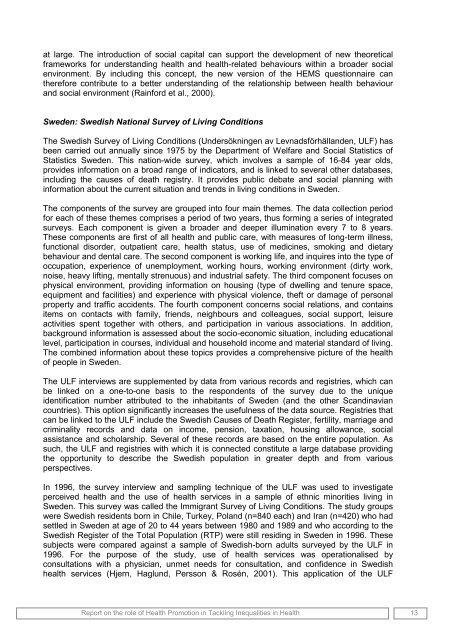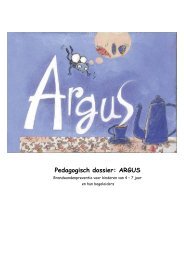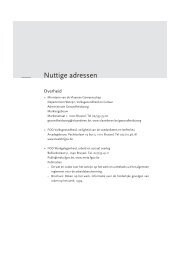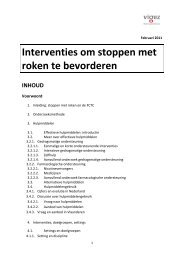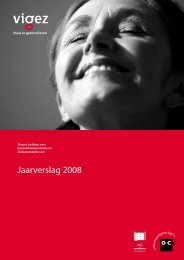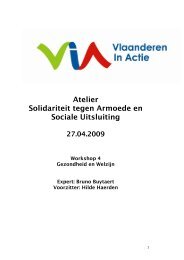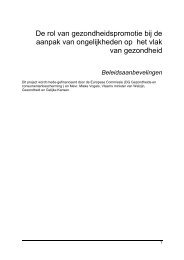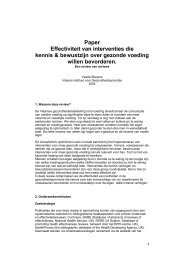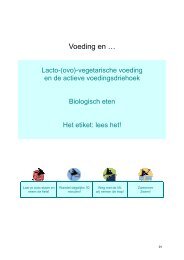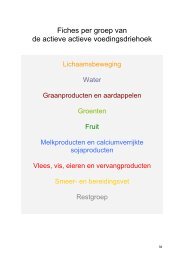Annex 1: Inventory of indicators from surveys and registries
Annex 1: Inventory of indicators from surveys and registries
Annex 1: Inventory of indicators from surveys and registries
You also want an ePaper? Increase the reach of your titles
YUMPU automatically turns print PDFs into web optimized ePapers that Google loves.
at large. The introduction <strong>of</strong> social capital can support the development <strong>of</strong> new theoretical<br />
frameworks for underst<strong>and</strong>ing health <strong>and</strong> health-related behaviours within a broader social<br />
environment. By including this concept, the new version <strong>of</strong> the HEMS questionnaire can<br />
therefore contribute to a better underst<strong>and</strong>ing <strong>of</strong> the relationship between health behaviour<br />
<strong>and</strong> social environment (Rainford et al., 2000).<br />
Sweden: Swedish National Survey <strong>of</strong> Living Conditions<br />
The Swedish Survey <strong>of</strong> Living Conditions (Undersökningen av Levnadsförhäll<strong>and</strong>en, ULF) has<br />
been carried out annually since 1975 by the Department <strong>of</strong> Welfare <strong>and</strong> Social Statistics <strong>of</strong><br />
Statistics Sweden. This nation-wide survey, which involves a sample <strong>of</strong> 16-84 year olds,<br />
provides information on a broad range <strong>of</strong> <strong>indicators</strong>, <strong>and</strong> is linked to several other databases,<br />
including the causes <strong>of</strong> death registry. It provides public debate <strong>and</strong> social planning with<br />
information about the current situation <strong>and</strong> trends in living conditions in Sweden.<br />
The components <strong>of</strong> the survey are grouped into four main themes. The data collection period<br />
for each <strong>of</strong> these themes comprises a period <strong>of</strong> two years, thus forming a series <strong>of</strong> integrated<br />
<strong>surveys</strong>. Each component is given a broader <strong>and</strong> deeper illumination every 7 to 8 years.<br />
These components are first <strong>of</strong> all health <strong>and</strong> public care, with measures <strong>of</strong> long-term illness,<br />
functional disorder, outpatient care, health status, use <strong>of</strong> medicines, smoking <strong>and</strong> dietary<br />
behaviour <strong>and</strong> dental care. The second component is working life, <strong>and</strong> inquires into the type <strong>of</strong><br />
occupation, experience <strong>of</strong> unemployment, working hours, working environment (dirty work,<br />
noise, heavy lifting, mentally strenuous) <strong>and</strong> industrial safety. The third component focuses on<br />
physical environment, providing information on housing (type <strong>of</strong> dwelling <strong>and</strong> tenure space,<br />
equipment <strong>and</strong> facilities) <strong>and</strong> experience with physical violence, theft or damage <strong>of</strong> personal<br />
property <strong>and</strong> traffic accidents. The fourth component concerns social relations, <strong>and</strong> contains<br />
items on contacts with family, friends, neighbours <strong>and</strong> colleagues, social support, leisure<br />
activities spent together with others, <strong>and</strong> participation in various associations. In addition,<br />
background information is assessed about the socio-economic situation, including educational<br />
level, participation in courses, individual <strong>and</strong> household income <strong>and</strong> material st<strong>and</strong>ard <strong>of</strong> living.<br />
The combined information about these topics provides a comprehensive picture <strong>of</strong> the health<br />
<strong>of</strong> people in Sweden.<br />
The ULF interviews are supplemented by data <strong>from</strong> various records <strong>and</strong> <strong>registries</strong>, which can<br />
be linked on a one-to-one basis to the respondents <strong>of</strong> the survey due to the unique<br />
identification number attributed to the inhabitants <strong>of</strong> Sweden (<strong>and</strong> the other Sc<strong>and</strong>inavian<br />
countries). This option significantly increases the usefulness <strong>of</strong> the data source. Registries that<br />
can be linked to the ULF include the Swedish Causes <strong>of</strong> Death Register, fertility, marriage <strong>and</strong><br />
criminality records <strong>and</strong> data on income, pension, taxation, housing allowance, social<br />
assistance <strong>and</strong> scholarship. Several <strong>of</strong> these records are based on the entire population. As<br />
such, the ULF <strong>and</strong> <strong>registries</strong> with which it is connected constitute a large database providing<br />
the opportunity to describe the Swedish population in greater depth <strong>and</strong> <strong>from</strong> various<br />
perspectives.<br />
In 1996, the survey interview <strong>and</strong> sampling technique <strong>of</strong> the ULF was used to investigate<br />
perceived health <strong>and</strong> the use <strong>of</strong> health services in a sample <strong>of</strong> ethnic minorities living in<br />
Sweden. This survey was called the Immigrant Survey <strong>of</strong> Living Conditions. The study groups<br />
were Swedish residents born in Chile, Turkey, Pol<strong>and</strong> (n=840 each) <strong>and</strong> Iran (n=420) who had<br />
settled in Sweden at age <strong>of</strong> 20 to 44 years between 1980 <strong>and</strong> 1989 <strong>and</strong> who according to the<br />
Swedish Register <strong>of</strong> the Total Population (RTP) were still residing in Sweden in 1996. These<br />
subjects were compared against a sample <strong>of</strong> Swedish-born adults surveyed by the ULF in<br />
1996. For the purpose <strong>of</strong> the study, use <strong>of</strong> health services was operationalised by<br />
consultations with a physician, unmet needs for consultation, <strong>and</strong> confidence in Swedish<br />
health services (Hjern, Haglund, Persson & Rosén, 2001). This application <strong>of</strong> the ULF<br />
Report on the role <strong>of</strong> Health Promotion in Tackling Inequalities in Health<br />
13


